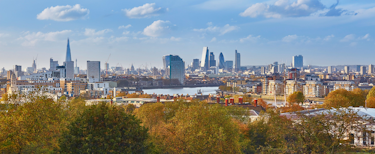Green Infrastructure & Green Networks
Green infrastructure is a term used to describe the networks of natural and semi-natural features that provide benefits to people. These features range from street trees to woodlands and from ponds to rivers.
The term ‘green infrastructure’ is closely related to the natural capital concept. The thinking behind green infrastructure focuses on the spatial arrangement of natural features as a network.
Actions to enhance green infrastructure take place at many scales, from an individual neighbourhood to the wider landscape.
A wide variety of organisations are advocating the benefits of green infrastructure. The Green Infrastructure Partnership draws together many of the people and organisations involved.
Government Guidance
- Official planning practice guidance for England explains how Green Infrastructure can help deliver wider planning policy
- Scottish government has produced a summary of current planning policy and advice on Green Infrastructure
Tools & Guides
The following links relate to practical tools and guides. See further down this page for links to documents that make the case for green infrastructure.
The Ecosystems Knowledge Network’s Tool Assessor service profiles analytical tools that appraise green infrastructure.
The Green Infrastructure Resource Library is a searchable database of documents, case-studies, videos, tools and other information about Green Infrastructure and its benefits.
The UK Green Building Council has published a range of resources including Biodiversity Net Gain Checklist and Demystifying Green Infrastructure. The latter report helps to define the topic of green infrastructure, its scope for those working in the built environment and describes the business case for creating and maintaining green infrastructure.
The report Assessing the Value of Green Infrastructure Tools in the UK, commissioned by Natural England, draws together a number of the most widely used tools and assesses them against research standards for natural science and economics. The aim is to help people wanting to value green infrastructure choose the best tool for them.
The Landscape Institute has produced a guide for local communities who wish to ensure that the natural environment is considered more fully in the way that neighbourhoods are planned, designed and managed.
Documents that make the case for Green Infrastructure
The University of Northumbria and University of Birmingham have published an assessment of how English planning policy supports green infrastructure provision. The report identifies best planning principles for green infrastructure and applies them in seven local authority case studies.
The Parliamentary Office of Science and Technology (Westminster) has published a briefing note on urban green infrastructure. It covers a variety of topics including the environmental, health and economic benefits of green infrastructure, challenges to its delivery and sources of funding.
The European Commission has published Building a Green Infrastructure for Europe. This describes various European green infrastructure initiatives and their relationship with nature conservation sites.
Science for Environment Policy has produced a report that describes the different functions that green infrastructure provides and the evidence behind these functions. It describes specific features of green infrastructure that delivers these functions, together with their costs and benefits.




Design & Construction
The RESTORE partnership has recently published the ‘Rivers by Design’ guide, aimed at explaining the benefits of river restoration to developers, local authorities, planners and communities, with relevance to urban or green infrastructure projects.
Scottish Government has produced a green infrastructure overview that identifies key design issues and techniques which can help to incorporate green infrastructure into place-making at all scales.
The Trees and Design Action Group have produced ‘Trees in the Townscape – a guide for decision makers‘. This guidance is aimed at helping decision makers realise the potential of trees in the urban environment. Its sets out 12 action-orientated principles which span the range of planning, design, works and management issues that need to be considered for maximum economic, social and environmental returns.
Local Authorities & the Planning Profession
The Town and Country Planning Association and Wildlife Trusts have published Planning for a healthy environment – Good practice guidance for green infrastructure and biodiversity. This guidance for planners helps local authorities ensure that local plans deliver a network of wildlife-rich places. It was prepared with input from a wide range of stakeholders with experience in planning green infrastructure and biodiversity.
Central Bedfordshire Council has produced Green Infrastructure Planning Obligations, a guidance note and project proposal form that asks applicants to demonstrate how a project meets the requirements of the Green Infrastructure Planning Obligations Fund. Planning obligations are the legal agreements between the planning authority, developer and other interested parties.
The Telford Access to Nature Partnership Project conducted a study on the methods used to appraise and assess areas for Green Infrastructure. A Research Report on the Methods Used to Appraise Green Infrastructure summarises the finding of a survey of how other local authorities appraise green infrastructure and who they include in the decision process.
Green Infrastructure, the economy & growth
This website also contains a variety of links on the economic valuation of ecosytem services and the natural environment and local economic development. The following links relate specifically to green infrastructure.
A Forestry Commission report on the economic benefits of greenspace provides a critical assessment of evidence from 2000-2011 of the net benefits of green infrastructure initiatives.
Defra and Natural England have funded a review from eftec and Sheffield Hallam University of Green Infrastructure’s contribution to economic growth. This has shown that investment in multi-functional green space or green infrastructure encourages inward investment and can attract increased visitor spending at a local level. It can also benefit national economic growth by helping reduce flood risk, improve air quality and provide health benefits.
Green infrastructure and health
The Royal Institute of British Architects has published City Health Check, a report that looks at three serious health problems in nine English cities, comparing the amount of green and public space available in each. The report shows that areas of the cities with the poorest health outcomes had the least amount of green space.
Green infrastructure and climate change
The Forestry Commission has published a Research Note on air temperature regulation by urban trees and green infrastructure. This examines how the type of tree, its planting location, together with the mix of vegetation and paved surfaces in greenspace all contribute to countering the effects of urban heat islands.
